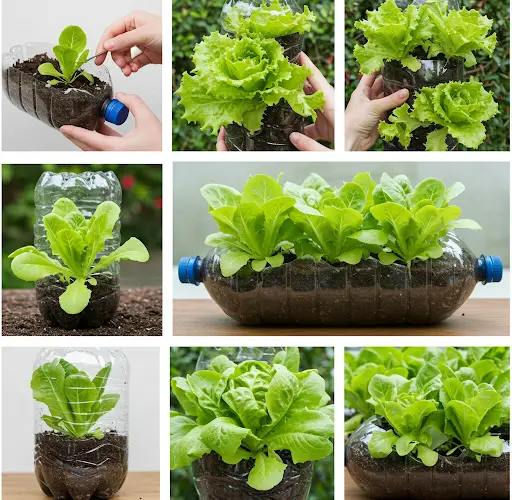Growing lettuce at home is one of the simplest and most satisfying ways to start a garden. Whether you live in a house with a backyard or an apartment with just a balcony, you can grow fresh, crisp lettuce with very little space and minimal effort. This guide walks you through a highly effective method for growing lettuce using plastic buckets or recycled containers — no garden required.
Why Grow Lettuce at Home?
Lettuce is fast-growing, low-maintenance, and perfect for container gardening. Here are a few reasons to start:
-
Freshness: Homegrown lettuce tastes better and is free of pesticides.
-
Savings: One packet of seeds or a head of store-bought lettuce can yield weeks of salad greens.
-
Convenience: You can harvest just the amount you need and grow year-round in many climates.
-
Sustainability: Reusing containers and reducing store-bought packaging is eco-friendly.
This method is great for beginners and doesn’t require any advanced gardening tools or techniques.
Materials You Will Need
-
A large plastic bucket (10 to 20 liters) or similar container
-
A drill or sharp tool to make drainage holes
-
Potting soil or compost-rich garden soil
-
Lettuce seeds (any variety: romaine, butterhead, leaf, etc.)
-
Watering can or spray bottle
-
Optional: tray or plate to catch excess water
If you’re reusing a bucket or container, make sure it’s food-safe and thoroughly cleaned before planting.
Step 1: Prepare the Container
Choose a bucket or pot that is at least 8–10 inches deep. Lettuce has shallow roots, so a medium-depth container works perfectly.
-
Drill or poke several drainage holes in the bottom to prevent water buildup.
-
Place the bucket on a tray or elevated surface to allow excess water to drain out.
If you prefer a decorative look, you can paint the outside of the bucket or wrap it with fabric, but avoid painting the inside.
Step 2: Fill with Soil
Fill the bucket about ¾ full with well-draining potting mix. A mix that contains compost, coconut coir, or perlite is ideal. You want the soil to retain moisture without becoming soggy.
Lightly press the soil down and water it so it’s evenly moist before sowing the seeds.
Step 3: Plant the Lettuce
There are two easy planting options:
-
Sow seeds directly: Sprinkle lettuce seeds evenly across the soil surface. Cover with a thin layer (about ¼ inch) of soil and gently press down.
-
Regrow from stems: If using leftover store-bought lettuce, trim the base (about 2 inches thick) and plant it upright in the center of the bucket. Keep the top above soil level.
Water gently using a spray bottle or watering can with a fine nozzle to avoid displacing seeds.
Step 4: Provide Light and Water
Place the bucket in a sunny location — at least 4 to 6 hours of sunlight per day. A balcony, windowsill, patio, or rooftop works well. In hotter regions, some light afternoon shade helps prevent bolting (early flowering).
Lettuce thrives in cool to mild temperatures, so early spring or fall is ideal, though it can be grown indoors year-round.
Keep the soil consistently moist but not soaked. Water lightly every day or two, especially in warm weather.
Step 5: Care and Maintenance
-
Thin the seedlings once they reach 2 inches tall, leaving the strongest 2–3 inches apart for proper growth.
-
Fertilize lightly every 2–3 weeks using compost tea or a diluted liquid organic fertilizer.
-
Check for pests like aphids or snails, especially around the base. Hand-pick or use neem oil as needed.
Because lettuce grows quickly, you’ll see real progress within just a couple of weeks.
Step 6: Harvesting
Most lettuce varieties are ready for harvest in 30–45 days, but you can begin picking baby leaves earlier if you prefer tender greens.
Use scissors to cut outer leaves first, leaving the inner part to continue growing. This “cut and come again” method allows for multiple harvests from one plant.
For head-forming lettuce, wait until the head is full and firm before cutting the entire plant.
Optional: Successive Planting
To ensure a continuous supply, plant new seeds every 2–3 weeks in separate buckets or containers. This way, you’ll always have fresh lettuce available.
You can also try growing different varieties for a more colorful and flavorful mix — green leaf, red oak, buttercrunch, and romaine are all excellent options for containers.
Conclusion
Growing lettuce at home in buckets or containers is an incredibly easy and affordable method that anyone can do — no garden required. With just a few basic materials and a bit of care, you can enjoy fresh, crisp greens right from your balcony, patio, or kitchen window. This method is perfect for beginners and offers fast, rewarding results.
Whether you’re looking to save money, reduce waste, or simply enjoy the taste of freshly harvested lettuce, this homegrown approach is an ideal starting point for your urban gardening journey.



